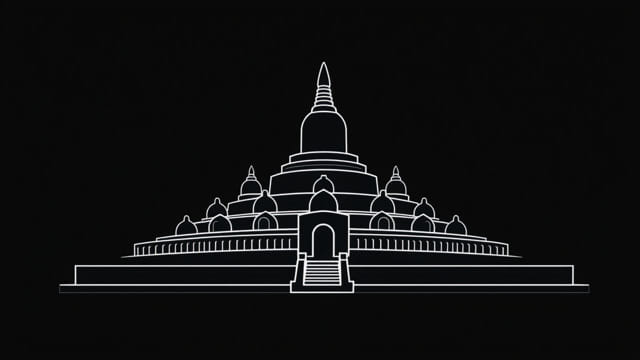Nestled in the heart of Central Java, Indonesia, Borobudur Temple is one of the most majestic monuments in Southeast Asia and a true marvel of Buddhist architecture. Built over 1,200 years ago, it has captivated the attention of archaeologists, historians, and travelers alike for generations. The temple’s structure, symbolism, and serene setting have earned it global recognition as a UNESCO World Heritage Site. Understanding the description of Borobudur is essential to appreciating the depth of its historical and cultural significance.
Historical Background of Borobudur
Borobudur was constructed during the 8th and 9th centuries under the Sailendra Dynasty, a powerful ruling family in Central Java. It is widely believed that the temple was built between 750 and 850 CE during the reign of King Samaratungga. The Sailendras were strong supporters of Mahayana Buddhism, which deeply influenced the design and purpose of Borobudur. The temple served as both a shrine to the Buddha and a pilgrimage site for devout followers.
Rediscovery and Restoration
After centuries of abandonment likely due to volcanic eruptions and the decline of Buddhist influence in Java Borobudur was rediscovered in the early 19th century by Sir Thomas Stamford Raffles, a British administrator. Restoration efforts have been ongoing since the early 20th century, with significant assistance from UNESCO and the Indonesian government to preserve the temple from natural degradation.
Architectural Description of Borobudur
Borobudur is an extraordinary example of Buddhist architecture fused with native Javanese design. The entire structure resembles a giant mandala when viewed from above, reflecting the universe in Buddhist cosmology. Built entirely from andesite stone, the temple stands on a hilltop overlooking lush green fields and distant volcanoes.
Terraced Layout
The temple is built in three main levels, representing the stages of enlightenment in Mahayana Buddhism:
- Kamadhatu (the world of desire) The base level, partly hidden by a support wall, represents the realm of earthly desires and passions.
- Rupadhatu (the world of forms) The middle terraces are square and feature hundreds of intricately carved relief panels that depict the Buddha’s life and teachings.
- Arupadhatu (the world of formlessness) The upper circular platforms represent the transcendence of physical form. These levels are adorned with bell-shaped stupas and serene Buddha statues facing outward.
Stupas and Buddha Statues
Borobudur contains a total of 72 perforated stupas on the top circular platforms. Each stupa houses a seated Buddha statue in a meditative pose. The largest central stupa crowns the temple and is solid, symbolizing ultimate enlightenment. The arrangement of these stupas creates a peaceful and sacred atmosphere, drawing visitors into a contemplative state.
Relief Panels and Symbolism
One of Borobudur’s most fascinating features is its 2,672 relief panels that stretch along its galleries for over 5 kilometers. These panels serve not only as artistic masterpieces but also as spiritual guides. They illustrate stories from Buddhist scriptures such as the Jataka tales, the Lalitavistara (life of the Buddha), and the Gandavyuha.
Educational and Spiritual Function
The relief panels are designed to be read in a clockwise direction, mimicking the ritual of circumambulation or ‘pradaksina,’ which is common in Buddhist practice. Pilgrims would walk along the paths, observing the carvings and meditating on their meanings, thereby embarking on a symbolic journey toward enlightenment. The narrative progression of the panels is both visual and philosophical, designed to educate and inspire.
Construction Techniques and Materials
The builders of Borobudur employed advanced knowledge of engineering and architecture. Each stone block was precisely carved and interlocked without the use of mortar. Drainage systems were built into the terraces to prevent water accumulation and erosion. Despite earthquakes, volcanic activity, and tropical rains, Borobudur has endured remarkably well for over a millennium.
Use of Andesite Stone
Andesite, a type of volcanic rock, was quarried locally and used extensively in the temple’s construction. Its durability has helped preserve the intricate carvings and structural integrity of Borobudur. The smooth surface of andesite also allowed for detailed artistic expression.
Religious and Cultural Importance
Borobudur is a significant symbol of Indonesia’s rich cultural heritage. While originally a Buddhist monument, it has become a shared treasure for people of various faiths and nationalities. The annual Vesak celebration, commemorating the birth, enlightenment, and death of the Buddha, is held at Borobudur and draws thousands of pilgrims from across the world.
Integration with Nature
One of the unique aspects of Borobudur is its integration with the surrounding landscape. The temple’s design reflects a harmony between human construction and natural beauty. From its summit, visitors can gaze across the Kedu Plain and admire the towering peaks of Mount Merapi and Mount Merbabu. This connection to nature reinforces the spiritual journey that Borobudur represents.
Modern Significance and Tourism
Today, Borobudur is one of the most visited tourist destinations in Indonesia. It plays a vital role in the local economy, providing income through cultural tourism and education. Preservation efforts have focused on balancing accessibility with conservation, ensuring that future generations can continue to experience its grandeur.
Challenges in Preservation
Borobudur faces ongoing challenges, including environmental degradation, tourism pressure, and natural disasters. Conservation strategies involve limiting visitor access to sensitive areas, using digital technologies for documentation, and fostering community engagement in cultural stewardship. Global recognition has helped increase awareness and funding for these efforts.
Borobudur Temple stands as a testament to Indonesia’s ancient civilization, religious devotion, and artistic brilliance. Its complex design, spiritual symbolism, and historical depth make it an unparalleled example of Buddhist architecture. Through centuries of change, Borobudur continues to inspire awe and reflection, reminding the world of the enduring power of human creativity and faith. Whether explored as a sacred pilgrimage site or a historical marvel, Borobudur remains a cultural treasure of global importance.
